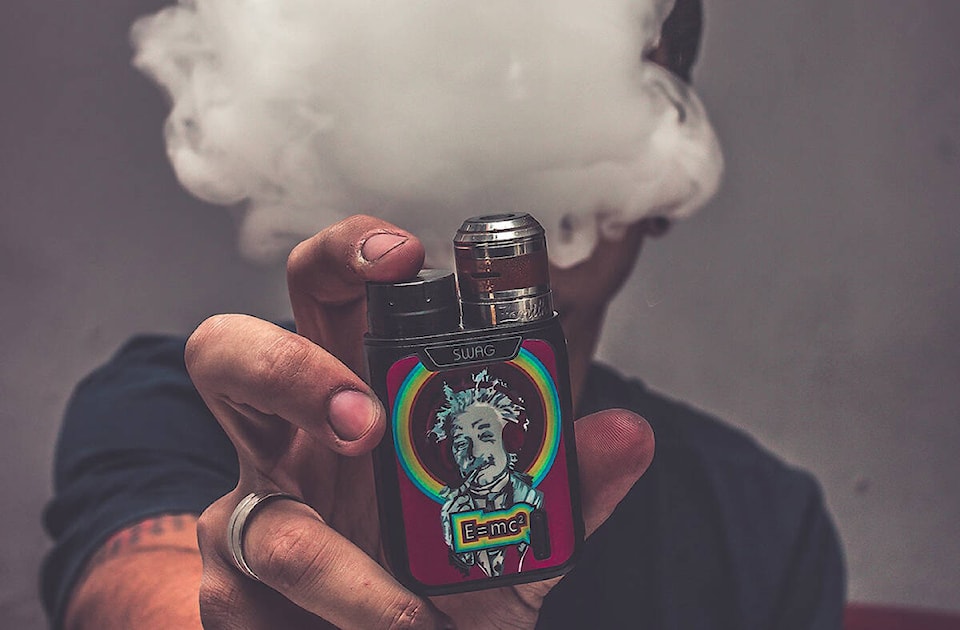Vaping has replaced smoking amongst South Cariboo teens.
These days it’s more common to see young people sneak a hit of their vape rather than light up a cigarette. It’s a trend that worries health professionals like Nicole Hargreaves and Jered Dennis, two of Interior Health’s Legal Substance Reduction coordinators.
“Really what we’ve seen in recent years is there has been an inverse relationship with smoking cigarettes, or commercial tobacco use, to vaping use. As cigarette use has been going down in communities, especially among youth, we’ve seen an uptick in vaping use among teens,” Hargreaves said.
Substance reduction co-ordinators are responsible for monitoring the use and abuse of legal substances such as alcohol, cannabis, cigarettes and vape products. They take a “population-level health approach” Hargreaves explained and support several programs across the region aimed at reducing cannabis, alcohol and nicotine use. Nicotine use especially has been on the rise in recent years thanks to vapes.
The 2018 BC Adolescent Health Survey found that 36 per cent of youth in the Thompson-Cariboo-Shuswap region had vaped within the last 30 days. While it’s just an educated guess, Dennis said it’s likely vape usage has increased since then. He noted that IH expects to have more up-to-date numbers within the next few weeks following the release of a new survey.
There are a variety of reasons why vapes have become the preferred substance among teens, Hargreaves explained. This includes how easy vapes are to conceal, peer pressure, the stress of everyday life and how normalized it’s been among teens in recent years.
One of the biggest factors, however, is the fact vaping has been perceived as less harmful than traditional tobacco products. Vape companies such as JUUL originally sold their product as a smoking cessation tool.
While vapes are better for smokers than cigarettes, they also became a way to hook a whole new generation on nicotine. Due to how relatively new vaping is, Dennis said doctors don’t truly know what potential health risks could emerge, especially among those who adopted the practice young. He did note however vapes can contain heavy metals and carcinogenic chemicals.
“There is this misconception that vapor products just contain water and that’s absolutely not the case. We know that water vapour contains a variety of different toxic chemicals that are inhaled through the lungs and mouth and then absorbed into the bloodstream,” Hargreaves said. “When that happens the chemicals enter your brain and organs through the blood and can have a really significant impact on adolescent brain development.”
Hargreaves said these effects can manifest themselves as impulsiveness, difficulties learning and paying attention and dependency. Nicotine itself is highly addictive and youth are most susceptible to becoming addicted.
Dennis pointed out that the human brain and lungs aren’t fully developed until the mid-twenties. When you introduce foreign substances to them while they’re still developing they can have a far more detrimental effect than they would on an adult.
“I’m not saying (vaping is) harmless for an adult, but there’s a greater risk of harm for a young person because they’re still in that developmental stage,” Dennis said. “We don’t know what the long-term impacts of vaping are, so we’re trying to play catch up to identify the burdens on health.”
Vapes can only be sold if they contain nicotine or cannabis, with a limit of 20 milligrams of nicotine per one millimeter of vape juice. When sold at a vape shop or convenience store they can only be sold to adults over the age of 19.
Dennis said that typically youth report they obtain vapes via an adult whether they be a friend, an older sibling or even their parents. Online sales have also become a significant way for teens to acquire vapes. The Tobacco and Vapour Act regulates online sales and requires the company delivering the items to verify the purchaser’s age.
According to a test done by the Centre for Addiction and Mental Health, Dennis said Canada Post is most effective at confirming customer’s ages. However, some of the other delivery services were not found to be as diligent.
One of the best ways to reduce youth vape use, Dennis said, would be to ban flavored vape products. Vape shops can still sell vapes flavoured like fruits and candies and he believes if they could only sell methanol or tobacco-flavoured products, like gas stations, use among youth would decline.
“Some of the common reasons why youth vape are flavours. Flavours are a significant appealing factor to youth vaping and I would suggest if the only flavours were tobacco flavour, we would reduce vaping rates,” Dennis said. “I firmly believe that. It’s an intervention or strategy that could be put in place that would significantly impact youth vaping rates.”
If you’re looking to help a teenager quit vaping, Dennis said you should initiate conversations with them about the habit. By talking to them about the risks associated with vaping from a place of education, not fear, you can delve into why they’re vaping and give them the support they need to quit. Hargreaves added that it doesn’t just take a one-off conversation, but instead an ongoing dialogue.
Dennis also recommends people looking to quit make use of the BC PharmaCare’s Smoking Cessation Program which provides everyone 12 weeks of free Nicorette patches and other smoking cessation tools. Youth can also download Quash, an app designed to help them reduce their use of vapes by allowing them to way the pros and cons of the habit.
“We often talk about quitting now, but even the reduction of the quantity and frequency of vaping products is a significant movement towards reducing the harm,” Dennis said. “Instead of hitting a vape five times in an hour, try to hit it once an hour. When you inhale the vape try not to inhale a huge amount of the aerosol.”




